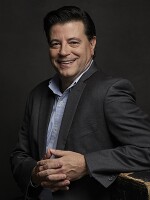Whether it was falling into a giant vat of morning cake batter in the 1970 children’s book “In the Night Kitchen,” or being whisked away to the island Wild Things in “Where the Wild Things Are,” the late Maurice Sendak had a knack for creating fantastical worlds in his books.
In his personal life, Sendak was fascinated from an early age with whimsical objects like puppets and toys, some of which are now on display in the exhibition “Swing into Action: Maurice Sendak and the World of Puppetry” at the Ballard Institute and Museum of Puppetry at the University of Connecticut in Storrs. Many of these objects have movement or a musical component to them.
“Maurice Sendak was not a puppeteer per se, but he was a huge proponent of movement,” said Matthew Sorensen, co-director of the Ballard Institute. “Things like 19th-century mechanical toys and moving artwork. He was also very fond of pop-up books and any kind of two-dimensional art that had a little more three dimensionality to it, a little interactivity.” Sorensen said that fascination goes back to Sendak’s childhood.

“As a matter of fact, in the 1940s he and his brother Jack Sendak prototyped and constructed small automatons that were inspired by fairy tale stories,” Sorensen said. “Jack did the engineering, and Maurice did the artistic design. They made them with the purpose of approaching FAO Schwarz to commission production on these to be sold in the store. But it never came to be.”
Several of those automatons are on display, including a Pinocchio and Aladdin pop-up toy.
The exhibit also focuses on Sendak’s love of collaboration with other creative people. On display are puppets from his collaborations with puppeteer Amy Luckenbach and the designs for his Macy’s Thanksgiving Day Parade balloon.

“Back in 1998 Bell Atlantic was using “Where the Wild Things Are” in an advertising campaign,” Sorensen said. “They made a giant balloon, and Maurice Sendak went down to the Macy’s shop and worked with the designers, artisans and technicians. He was fascinated with their work.”
One of Sendak’s closest collaborators was film director Spike Jonze, who adapted “Where the Wild Things Are” into a feature-length film in 2009. Jonze would later direct a documentary about Sendak.
“Spike and Maurice were very close,” Sorensen said. Spike took some liberties in the film, and Maurice said, ‘This is your version of the story, you tell it the way you need to.’ And that kind of freedom I think is really admirable and so special.”
The Ballard Institute has an on-demand conversation with Spike Jonze about his relationship with Sendak. The exhibition “Swing into Action: Maurice Sendak and the World of Puppetry” runs through Dec. 16 at the Ballard Institute and Museum of Puppetry.



